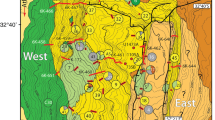Abstract
The junction between oceanic crust generated, within the Antarctic plate, at the Southeast Indian Ridge and the Southwest Indian Ridge has been studied using a SEABEAM swathe bathymetry mapping system and other geophysical techniques between the Indian Ocean Triple Junction (approximately 25°S, 70° E), and a point some 500 km to the southwest (at 28°25′ S, 66°35′ E). The morphotectonic boundary which marks this trace of the ridge-ridge-ridge triple junction is complex and varies with age. Recent theories proposing a cyclicity of volcanic and tectonic processes at this mode of triple junctions appear to be supported by a series of regularly spaced, en echelon escarpments facing the slowly spreading (0.6 to 0.8 cm a-1, half rate) Southwest Indian Ridge axis. The en echelon escarpments intersect at approximately right angles with the regularly spaced oceanic spreading fabric formed on the Antarctic plate at the Southeast Indian Ridge and together locally flank uplifted northward-pointing ‘corner’ sections of ocean floor. The origins for the localised elevations are unclear, but may relate to intermittent and/or alternating rifting and volcanic episodes. Variations of degree of asymmetry and/or obliquity in spreading on the Central Indian Ridge and the Southwest Indian Ridge are suggested to explain detailed structural changes along the triple junction trace. It is suggested that discontinuities of the trace may be related to an intermittent development of new spreading centres beneath the most easterly part of the Southwest Indian Ridge, coupled with a more continuous process beneath the faster spreading Central Indian Ridge (2 to 2.5 cm a-1) and the Southeast Indian Ridge (2.5 to 3 cm a-1). A detailed history of triple junction evolution may be thus inferred from basic morphological and structural mapping along the three triple junction traces.
Similar content being viewed by others
References
HeyR. N., 1977, Tectonic Evolution of the Cocos-Nazca Spreading Centre, Bulletin of the Geological Society of America 88, 1404–1420.
JohnsonG. L., HeyR. N., and LowrieA., 1973, Marine Geology in the Environs of Bouvet Island and the South Atlantic Triple Junction, Marine Geophys. Res. 2, 23–36.
McKenzieD. P. and MorganW. J., 1969, The Evolution of Triple Junctions, Nature 224, 125–133.
Munschy, M., 1987, Etude geophysique détaillée du point triple de Rodriguez et de la zone axiale des trois dorsales associées (Océan Indien), Thèse de Doctorat, Université Louis Pasteur, Strasbourg.
NaarD. F. and HeyR. N., 1986, Fast Rift Propagation along the East Pacific Rise, J. Geophys. Res. 91, 3425–3438.
ParsonL. M., SearleR. C., MitchellN., PatriatPh., 1987, Unlinked RRR Triple Junctions: Evidence from the Indian Ocean, Galapagos and Afar. (Abs), EOS 68, 1508.
Patriat, Ph., 1987, Reconstitution de l'évolution du système de dorsales de l'Océan Indien par les méthodes de la cinématique des plaques. Territoire des Terres Australes et Antarctiques Françaises, 308 pp.
PatriatPh and CourtillotV., 1984, On the Stability of Triple Junction and its Relation to Episodicity in Spreading, Tectonics 3, 317–332.
PitmanW. C. and HayesD. E., 1968, Sea-floor Spreading in the Gulf of Alaska, J. Geophys. Res. 13, 6511–6580.
RibetdeB. and PatriatPh., 1988, La région axiale de la dorsale ouest-indienne entre 53° Est et 59° Est, Marine Geophys. Res. 10, 139.
SchlichR., MunschyM., RoyerJ. Y., SchamingM., MarthelotJ. M., and WhitechurchH., 1984, Survey of the Indian Ocean Triple Junction, EOS. 65, 439 (abstract).
Schlich, R., Munschy, M., Royer, J. Y., Montigny, R., and Whitechurch, H., 1985, French Proposals ODP Sites in the Indian Ocean, in Schlich, R. and Munschy, M. (eds.), French Proposals for Oceanic Drilling in the Indian and Southern Oceans, IPG Strasbourg, ODP-France 1, 1–39.
SclaterJ. G., BowinC., HeyR., HoskinsH. PeirceJ., PhillipsJ., and TapscottC., 1976, The Bouvet Triple Junction, J. Geophys. Res. 81, 1857–1869.
SclaterJ. G., FisherR. L., PatriatPh., TapscottC., and ParsonsB., 1981, Eocene to Recent Development of the South West Indian Ridge, a Consequence of the Evolution of the Indian Ocean Triple Junction, Geophys. J. Roy. Astrom. Soc. 64, 587–604.
SearleR. C., 1980, Tectonic Pattern of the Azores Spreading Centre and Triple Junction, Earth Planet. Sci. Letters 51, 415–434.
SearleR. C., 1986, GLORIA Investigations of Oceanic Fracture Zones: Comparative Study of this Transform Fault Zone, J. Geol. Soc. London 143, 743–756.
SearleR. C. and FrancheteauJ., 1986, Structure and Evolution of the Galapagos Triple Junction, Marine Geophys. Res. 8, 95–129.
TapscottC. R., PatriatPh., FisherR. L., SclaterJ. G., HoskinsH., and ParsonsB., 1980, The Indian Ocean Triple Junction, J. Geophys. Res. 85, 3969–4723.
Author information
Authors and Affiliations
Rights and permissions
About this article
Cite this article
Patriat, P., Parson, L. A survey of the Indian ocean triple junction trace within the Antarctic plate. Implications for the junction evolution since 15 Ma.. Mar Geophys Res 11, 89–100 (1989). https://doi.org/10.1007/BF00285660
Received:
Revised:
Issue Date:
DOI: https://doi.org/10.1007/BF00285660




